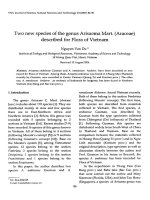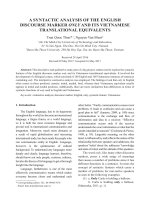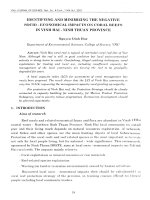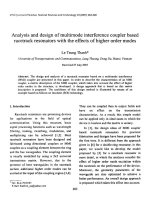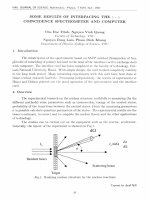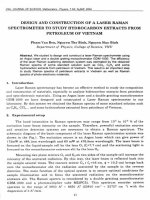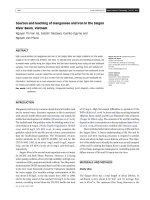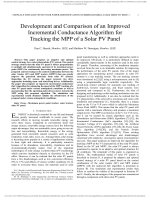DSpace at VNU: RUBY AND SAPPHIRE FROM THE TAN HUONG-TRUC LAU AREA, YEN BAI PROVINCE, NORTHERN VIETNAM
Bạn đang xem bản rút gọn của tài liệu. Xem và tải ngay bản đầy đủ của tài liệu tại đây (2.9 MB, 14 trang )
RUBY AND SAPPHIRE FROM THE
TAN HUONG–TRUC LAU AREA,
YEN BAI PROVINCE,
NORTHERN VIETNAM
Nguyen Ngoc Khoi, Chakkaphan Sutthirat, Duong Anh Tuan,
Nguyen Van Nam, Nguyen Thi Minh Thuyet, and Nguy Tuyet Nhung
Primary and secondary deposits in the Tan Huong–Truc Lau area of northern Vietnam’s Yen Bai
Province have supplied rubies (especially star rubies) and some sapphires—mostly of cabochon
quality—for more than a decade. The gems are typically translucent to semitransparent and pink
to purplish or brownish red, with rare color zoning. The most distinctive features of this corundum after polishing include growth zoning and asterism. The samples contain relatively high
amounts of Fe and variable Ti and Cr. The geologic origin and gemological properties of this
corundum are distinct from that of the adjacent Khoan Thong–An Phu area.
F
or more than 20 years, Vietnam’s Yen Bai
Province, and the Luc Yen District in particular,
have been widely known for producing highquality rubies and sapphires. Subsequent deposits
found elsewhere in Vietnam (Long et al., 2004)
include Quy Chau–Quy Hop (Nghe An Province), Di
Linh (Lam Dong), Dak Ton (Dak Nong), and Ma Lam
and Da Ban (Binh Thuan). Still, Yen Bai remains the
country’s most important source of ruby and sapphire. Much of the production consists of cabochonquality stones from the Tan Huong–Truc Lau area
(e.g., figure 1), as described in this article.
Vietnamese geologists first discovered gem-quality corundum and spinel at Luc Yen in 1983 (Vinh,
1991). In early 1987, the Geological Survey of
Vietnam found abundant gem material in alluvium
in Luc Yen’s Khoan Thong area. Mining activity
soon thrived, with many companies operating in the
region (Voi, 1991). Other gem occurrences near
Khoan Thong followed, such as Nuoc Ngap, Hin
Om, Khau Nghien, Vang Sao, May Thuong, May Ha,
An Phu, Phai Chap, Tan Lap, and Lam Dong. These
Figure 1. These star rubies (6.16–11.66 ct) are from
the Tan Huong–Truc Lau area of northern Vietnam.
Photo by Nuttapol Kitdee, GIA, Bangkok.
See end of article for About the Authors and Acknowledgments.
GEMS & GEMOLOGY, Vol. 47, No. 3, pp. 182–195,
/>© 2011 Gemological Institute of America
182
RUBY AND SAPPHIRE FROM NORTHERN VIETNAM
GEMS & GEMOLOGY
FALL 2011
H
AG
IANG
HA
GIANG
YEN
YEN BAI
BAI P
PROVINCE
ROVINCE
CHINA
CHINA
Ch
ay
L
UC Y
EN
LUC
YEN
Ri
✪
HANOI
HANOI
ve
Khoan
K hoan Thong
T hong
T
UYEN QUANG
QUANG
TUYEN
To
n
ki
n
r
Lang
L
ang C
Chap
hap
Re
of
HAINAN
HAINAN
Gu
lf
LAO
L
AO C
CAI
AI
dR
Y
en T
he
Yen
The
M
in
nh
hT
ien
Minh
Tien
N
Nuoc
uoc N
Ngap
gap
iv
er
An
A
nP
Phu
hu
T
ruc L
au
Truc
Lau
N
g i Nhau
go
Nha
h u
Ngoi
So
LLAOS
AO S
uth
V
AN Y
EN
VAN
YEN
Ch
T
THAILAND
HAIL AND
ina
MU
M
UC
CANG
ANG C
CHAI
HAI
M
au A
Mau
Y
YEN
EN B
BAI
AI
YEN
E N BINH
BINH
ThY
ac B
aL
ak
e
S
lope 7
00
Slope
700
Mong
M
ong S
Son
on
Tan H
T
uong
Tan
Huong
Tan
T
Dong
o g
on
an D
Sea
Hoa
H
oa Cuong
Cuong
o Phuo
Ph u o
Co
C
✪
Yen
Y
e n Bai
B a i City
Cit y
C
A MBODIA
CAMBODIA
inh
Yen
Y
Ye
en B
Binh
TRAN
T
R AN Y
YEN
EN
VIETNAM
VIE TNA M
P
HU T
HO
PHU
THO
SON
ON L
LA
A
T
R AM T
AU
TRAM
TAU
VAN
V
AN C
CHAN
HAN
CORUNDUM DEPOSITS
N
Khoan Thong-An Phu area
arre
ea (“old
(“o mines”)
0
Figure 2. In northern
Vietnam’s Yen Bai
Province, primary and
secondary corundum
deposits have been
mined on both sides of
the Chay River: the original Khoan Thong–An
Phu mines on the east
side and the newer Tan
Huong–Truc Lau mines
on the west. The size of
each symbol is proportional to the importance
of that mining area.
Modified after Xuyen
(2000) and Vinh (2005).
25 km
Primary
Secondary
Tan
Huong-Truc
T
an Huong-T
ruc Lau area
arre
ea (“new
(“ne mines”)
Primary
Secondary
Road
River or lake
Province
Pr
ovince boundary
District boundary
are located on the east side of the Chay River and
have been referred to by locals as bãi cu˜ , or “old
mines” (see figure 2).
In the mid-1990s, several bãi mói (“new mines”)
were established on the west side of the Chay River.
These included Tan Huong, Truc Lau, kilometer 12
of National Road 70, Tan Dong, Hoa Cuong, Cam
An, Bao Ai, Ngoi Nhau, and Ngoi Hop (again, see figure 2). Although corundum was discovered in this
area in 1986 (Quan et al., 1998), there was no significant mining until local diggers arrived at Tan Huong
in 1994 (Thang, 1998). In 1996 the Vietnam National
Gold and Gem Corporation (VIGEGO) conducted
systematic assessments of Tan Huong (covering an
area of 6 km2) and Truc Lau (20 km2). Official mining operations by VIGEGO started at Tan Huong the
following year, yielding hundreds of kilograms of
ruby and star ruby (Thang, 1998). Subsequently,
other secondary (placer) and primary occurrences
were discovered and mined (e.g., Quan et al., 2000).
Currently, the only large-scale mechanized operation (figure 3) belongs to DOJI Gold & Gems Group
Figure 3. DOJI Gold &
Gems Group currently
conducts the only largescale mining activities
in the Tan Huong–Truc
Lau area. These 2010
photos show open-pit
mining at Truc Lau (left)
and the associated processing plant (right).
Photos by N. N. Khoi.
RUBY AND SAPPHIRE FROM NORTHERN VIETNAM
GEMS & GEMOLOGY
FALL 2011
183
occurrences occupy the northeastern part of Yen Bai
Province, ~250 km northwest of Hanoi. From the
city of Yen Bai, it is easy to reach the new mining
area by driving northwest along National Road 70,
along which most of the occurrences are located.
This article describes the geology and gemological characteristics of gem corundum from Tan
Huong–Truc Lau and compares it to the material
from the well-known Luc Yen deposits.
GEOLOGY AND OCCURRENCE
Figure 4. Local miners dig for spinel and corundum
at the Lang Chap occurrence in June 2010.
Photo by N. N. Khoi.
in the Truc Lau valley. Also some small-scale mining using primitive methods occurs sporadically,
particularly during the dry season. Most recently, in
February 2010, hundreds of local miners began operating illegally at Lang Chap, mostly for spinel (figure 4).
The mines on the west side of the Chay River
typically yield cabochon-quality ruby and pink sapphire. However, some very large rubies weighing
tens of kilograms have been found. Some of these
contain transparent, gem-quality portions that can
be faceted. A semitransparent to nearly transparent
290 ct fragment, detached from a 2.58 kg rough ruby
discovered at Tan Huong in 1997, sold for
US$290,000 at the Rangoon Gem Emporium
(Myanmar) later that year (Nguyen Xuan An, pers.
comm., 1998). Large star rubies and pink sapphires
are also known. Two pieces (1.96 and 2.58 kg) now
belong to the State Treasury’s collection, while DOJI
Gold & Gems Group has preserved an 18.8 kg specimen (figure 5).
For the sake of clarity, we will refer to the original
deposits on the east side of the Chay River as Khoan
Thong–An Phu and to the newer localities on the
west side as Tan Huong–Truc Lau (the latter names
are the main mining areas). The older deposits also
have been referred to in the literature as simply Luc
Yen (Kane et al., 1991; Long et al., 2004; Garnier et
al., 2008), while the newer ones have been called Yen
Bai (Long et al., 2004). This terminology is potentially confusing because Khoan Thong, An Phu, and
Truc Lau administratively belong to the Luc Yen
District, while Tan Huong is part of the Yen Binh
District (again, see figure 2). Nevertheless, all of these
184
RUBY AND SAPPHIRE FROM NORTHERN VIETNAM
The Khoan Thong–An Phu and Tan Huong–Truc Lau
mining regions lie about 15 km from one another,
but their geologic settings are clearly different. Most
primary and secondary corundum occurrences in the
Tan Huong–Truc Lau area are located within the Dãy
Núi Con Voi mountain range, which stretches from
Figure 5. The 18.8 kg Great Star Ruby, one of many
large gems mined at Tan Huong–Truc Lau, belongs to
DOJI Gold & Gems Group. The stone measures
approximately 32 × 24 × 17 cm and has been partly
tumbled and polished to reveal its asterism. Photo by
N. N. Khoi.
GEMS & GEMOLOGY
FALL 2011
KEY
To
QUATERNARY
Sediments
La
o
Ca
i
Ch
ay
NEOGENE
Sediments
Khoan Thong
Ri
ve
r
LO
Lang Chap
PALEOGENE
Tan Huong Complex: biotite granite,
granosyenite, and pegmatite
GA LUC YEN
M
ZO
NE
Truc Lau
TRIASSIC
Nui Chua Complex: pyroxene gabbro,
gabbrodiorite, hornblende diorite
Minh Tien
R
Phia Bioc Complex: biotite granite,
pegmatite, and aplite
ED
An Phu
R
NEOPROTEROZOIC-CAMBRIAN
An Phu Formation: graphite-bearing
marble, two-mica schist
IV
ER
SH
EA
Thac Ba Formation: quartz-mica
schist, epidote-biotite-hornblende
schist, marble
R
Thac Ba
Lake
ZO
N
E
PALEO-MESOPROTEROZOIC
Ngoi Chi Formation: quartz-biotitesillimanite-garnet schist, amphibolite,
marble
Mong Son
Bao Ai
Re
dR
iv
er
Nui Voi Formation: biotite-sillimanitegarnet plagiogneiss, amphibole gneiss,
amphibolites, diopside marble
Kinh La
Figure 6. This simplified
geologic map shows the
locations and rock formations of the corundum
occurrences at Khoan
Thong–An Phu and Tan
Huong–Truc Lau.
Modified after Vinh
(2005) and Xuyen (2000).
Smaller deposits are not
shown here.
CORUNDUM DEPOSITS
Tan Huong
To
Khoan Thong–An Phu area (“old mines”)
Ha
no
Primary
Secondary
i
Tan Huong–Truc Lau area (“new mines”)
TRAN YEN
R70
0
Primary
Secondary
Fault
Road
10 km
Yen Bai City
Lao Cai Province southeast to Yen Bai Province. The
mountains are bounded by lateral strike-slip faults
(figure 6) forming a major Cenozoic geologic discontinuity in Southeast Asia known as the Ailao
NEED TO KNOW
• Northern Vietnam’s Yen Bai Province has produced ruby and sapphire from adjacent geologically distinct areas referred to as “Luc Yen” and
“Yen Bai.”
• The latter area pertains to deposits (both primary
and secondary) located on the west side of the
Chay River in the Tan Huong–Truc Lau area.
• Since the mid-1990s, these deposits have produced mainly cabochon-quality rubies (especially star rubies) and some sapphires.
• Although large pieces are known, the corundum
is typically semitransparent to translucent, and
most ranges from pink to purplish or brownish red.
Shan–Red River Shear Zone (Trinh et al., 1998, 1999;
Leloup et al., 2001).
Rocks in the Tan Huong–Truc Lau area mainly
consist of plagiogneiss and other gneisses intercalat-
RUBY AND SAPPHIRE FROM NORTHERN VIETNAM
ed with lenses of amphibolite and marble; they are
grouped as the Nui Voi Formation (Long et al., 2004;
Nam, 2007; Garnier et al., 2008; again, see figure 6).
These rocks underlie the Ngoi Chi Formation,
which comprises schist, amphibolite, and marble.
Both formations appear to have been intruded by
granite, syenite, and pegmatite of the Tan Huong
magmatic complex, which is 22–25 million years old
(Nam and Huyen, 2010).
Primary corundum deposits in the Tan
Huong–Truc Lau area can be classified into three
main types:
1. Gray, grayish white to bluish gray, and yellowish gray corundum embedded in gneisses, such
as the Co Man outcrop in Truc Lau valley, and
the Khe Nhan and Kinh La occurrences in the
Tan Huong area (Nam, 2007; Thuyet, 2008).
The corundum usually consists of large (1–3
cm, with some over 10 cm) well-formed crystals of very low or non-gem quality (Nam, 2007;
Thuyet, 2008; figure 7, left).
2. Dark red to pinkish red rubies of low-to-medium gem quality. These are usually also large
and come from weathered pegmatoid feldspathic rocks (e.g., the occurrences at kilometers 12,
GEMS & GEMOLOGY
FALL 2011
185
Figure 7. The left sample
of corundum-bearing
gneiss, from Co Man, contains mainly feldspar,
biotite, sillimanite, and
sapphire crystals up to 3
cm long. The feldspathic
rock from the Slope 700
outcrop (right) typically
consists of K-feldspar,
biotite, and ruby. Photos
by N. V. Nam.
15, and 23 along National Road 70, and also
Slope 700).
3. Rubies in large marble lenses intercalated within gneiss, mica schist, and amphibolites (e.g.,
the Tan Huong drill core, and DOJI’s Truc Lau
mine). This type of ruby appears to have higher
gem quality, but its distribution is limited.
These occurrences, mostly related to gneisses and
schists of metasedimentary origin, are much different from the corundum deposits of Khoan
Thong–An Phu, which are mainly hosted by marble
formations.
The corundum-bearing host rocks in the Tan
Huong–Truc Lau area appear to have originated from
the metamorphism of fine-grained sediments of variable composition (Katz, 1972; Simandl and Paradis,
1999). For example, gneisses from the Co Man and
Kinh La outcrops have a wide compositional range,
from 50–90% feldspar, up to 40% biotite, and up to
20% sillimanite. In addition, ruby-bearing feldspathic
rocks (e.g., the Slope 700 outcrop) typically consist of
K-feldspar and biotite (or vermiculite; figure 7, right).
The primary host rocks are usually deeply weathered,
forming numerous eluvial deposits.
The secondary (eluvial and alluvial) corundum
deposits usually contain dark red ruby, pink sapphire, and red and brown spinel, as well as some garnet, trapiche-like bluish gray sapphire, sillimanite,
and quartz. Of these mining areas, Truc Lau and Tan
Huong are the most important. Truc Lau occupies a
large valley, about 5 km long, that contains eluvial
and alluvial sediments. The eluvium consists of
three layers: topsoil (averaging 1 m thick); a gembearing layer (0.8–1 m thick) containing corundum
and spinel that is composed of pebbles, gravel, and
sand; and a deeply weathered gneiss layer (3 m thick)
that typically contains ruby and sapphire. Compared
to the eluvium, the alluvial deposits at Truc Lau are
thicker (~10 m). Ruby, sapphire, and spinel are found
within a gravel paleoplacer (1.2–5.0 m thick) that
lies on bedrock, and is buried below 0.5–3.5 m of
Quaternary sediments and 0.5–1.5 m of topsoil
(figure 8). In 2002, 1–2 kg per month of pink sapphire
and star ruby were produced from this paleoplacer.
At Tan Huong, the main gem occurrences are
Figure 8. Alluvial layers in the Tan Huong–Truc Lau area consist of soil, sandy and pebbly clays,
and gravels containing gem corundum.
Cross-section of alluvial layers
Layer 1
(0.5-1.5 m): Soil
Layer 2
(0.5-3.5 m): Sandy and pebbly clay
with small-sized corundum and spinel
Layer 3
(1.2-5.0 m): Pebbly and sandy gravel
with gem-quality corundum and spinel
Layer 4
Bedrock (gneiss)
186
RUBY AND SAPPHIRE FROM NORTHERN VIETNAM
GEMS & GEMOLOGY
FALL 2011
arranged in a northwesterly direction, bounded by
two small lakes. The alluvial deposits consist of a
topsoil layer (~0.5 m thick); a sand horizon with
areas of humus (~0.5–1 m thick); and a ruby-, sapphire-, and spinel-bearing layer above the bedrock
that contains mixed sand, pebbles, and boulders
(~1.2–2.5 m thick). All of the alluvial deposits in the
Tan Huong–Truc Lau area are quite similar to those
shown in figure 8.
PRODUCTION AND DISTRIBUTION
Current production of gem material from Tan
Huong–Truc Lau is about 10 kg per month. This
includes approximately 20–30% ruby and some sapphire, and 70–80% spinel. Only 10–15% of the
stones are of gem quality; the rest are suitable for
carving material or as specimens. Most of the gems
are cut and sold locally. DOJI Gold & Gems Group
is the major exporter of faceted Vietnamese gemstones to the world market, either directly or
through the international gem fairs in Bangkok,
Hong Kong, Tokyo, and Kobe. The main markets for
high-quality corundum are Japan, North America,
and Hong Kong. Large, medium-quality stones are
sold in the Middle East, Taiwan, and Southeast Asia,
while low-quality commercial products go to India
and China.
Heat treatments, including lead-glass filling, have
been applied to these materials, but most appear to
be unsuccessful. After heat treatment, white stripes
often appear along fractures.
MATERIALS AND METHODS
A total of 57 gem samples from Tan Huong–Truc
Lau, including 15 rough and 42 cut stones (12
faceted and 30 cabochons), were collected by the
authors over a period of many years, and examined
as summarized in table 1. Among these, 29 cut samples (nine faceted and 20 cabochons) and 10 pieces of
rough were from secondary deposits (e.g., figure 9).
The remaining 13 cut samples (three faceted and 10
cabochons) and five pieces of rough were from primary host rocks (e.g., figure 10) along National Road
70, at kilometers 12, 15, and 23, and at Slope 700.
All of these were gem quality, although those from
primary occurrences typically were of much lower
quality.
We used standard gemological equipment to
record optic character, refractive indices and birefringence, pleochroism, absorption spectra, and UV fluorescence (to long- and short-wave radiation). Specific
RUBY AND SAPPHIRE FROM NORTHERN VIETNAM
gravity was measured by the hydrostatic method
using an electronic balance. Various gemological
microscopes (vertical and horizontal, incorporating
different lighting techniques) were used to observe
internal features.
Raman microspectroscopy was performed on nine
observable mineral inclusions embedded in transparent hosts. The spectra were collected using a Jobin
Yvon LabRam HR 800 spectrometer coupled with an
Olympus BX41 optical microscope and an Si-based
CCD (charge-coupled device) detector at the Institute
of Geosciences, Johannes Gutenberg University
(Mainz, Germany). The samples were excited by a
514 nm Ar-ion laser. The confocal mode was used to
enable analysis at the micron scale (~0.2–0.5 µm).
Absorption spectra of three Tan Huong–Truc Lau
rubies were collected using a Shimadzu UV-2450
UV-Vis spectrophotometer at the Center for
Material Sciences, Hanoi University of Science.
Polished thin sections of 23 samples selected
from primary and secondary deposits at Truc Lau
and Tan Huong were prepared for quantitative
chemical analysis by electron microprobe. The analyses were performed using three different instruments, as indicated in table 2. Also analyzed were 29
mineral inclusions exposed on the polished surfaces.
GEMOLOGICAL CHARACTERISTICS
Crystal Morphology. Two main crystal forms characterized the morphology of the corundum from primary deposits:
1. Prismatic crystal habits composed of the hexag–
onal prism a {1120} and basal pinacoid c {0001}
2. A modification of this habit, with the addition
–
of the positive rhombohedron r {1011}
The crystals had short prismatic and sometimes
tabular hexagonal shapes, with a height-to-width
ratio ranging from 1 to 3.
Visual Appearance. In general, rubies and sapphires
from Tan Huong–Truc Lau are only of cabochon
quality. Transparent to semitransparent pieces
with more marketable red to pink colors occur in
secondary deposits, while those extracted from primary deposits are usually opaque to translucent
and have dull to dark colors unsuitable for cutting.
Corundum from the primary deposits ranges from
colorless to gray, pale blue, and yellowish to dark
red and violetish pink; only the latter is typically of
gem quality (again, see figure 10). Corundum from
GEMS & GEMOLOGY
FALL 2011
187
TABLE 1. Gemological characteristics of rubies and sapphires from Tan Huong–Truc Lau, Vietnam.
Primary deposits
Secondary deposits
Property
No. of samples
Color
13 polished
Pleochroism
13 polished
Diaphaneity
5 rough,
13 polished
Refractive Indices
3 faceted
10 cabochon
Birefringence
Optic character
Specific gravity
UV fluorescencea
3 faceted
3 faceted
5 rough,
13 polished
5 rough,
13 polished
Spectroscope
spectrum
5 rough,
13 polished
Internal features
5 rough,
13 polished
a Abbreviations:
Observations
Colorless, gray to yellowish gray,
bluish or greenish gray
Dark red, red to pink, purplish
pink
Weak to moderate
Dark red to red, pink: Violet to
violetish red, orange to orangy red
Bluish gray: Greenish gray to
bluish gray
Poor to moderate clarity and
opaque to translucent; rarely
semitransparent to transparent
no = 1.762–1.763
ne = 1.770–1.771
n = 1.76–1.77 (spot method)
0.008–0.009
Uniaxial negative
3.91–3.99
Gray to white, bluish gray:
Inert to both LW and SW
Red to pink:
• LW: Moderate to weak red
• SW: Weak red
Red to pink: Chromium spectra
Bluish and greenish gray: 450 nm
(faint line)
• Ilmenite, plagioclase, biotite,
muscovite, apatite, zircon, rutile
needles, magnetite, chlorite
• Primary and secondary liquid-gas
inclusions
• Growth zoning, parting, fractures,
lamellar twinning
No. of samples
Observations
29 polished
Pink, pinkish to purplish and
brownish red, dark red
29 polished
Moderate to strong
Dark red to red, pink: Violet to violetish
red, orange to orangy red
10 rough,
29 polished
Poor to moderate clarity, opaque to
translucent and semitransparent;
some parts may be transparent
no = 1.762–1.763
ne = 1.770–1.771
n = 1.76–1.77 (spot method)
9 faceted
20 cabochon
9 faceted
9 faceted
10 rough,
29 polished
10 rough,
29 polished
0.008–0.009
Uniaxial negative
3.92–4.07
10 rough,
29 polished
Red to pink: Chromium spectra
10 rough,
29 polished
• Rutile (needles, silk, clouds, and
stringer formations), ilmenite, zircon, apatite, spinel, diaspore, plagioclase, biotite, muscovite, chlorite, allanite(?), magnetite
• Primary and secondary liquid-gas
inclusions
• Growth zoning, parting, fractures,
lamellar twinning
Red to pink:
• LW: Moderate to strong red
• SW: Weak to moderate red
LW = long-wave, SW = short-wave.
Figure 9. These rough and cut rubies are from secondary deposits at Truc Lau. The cabochons on the right
range from 8.24 to 19.53 ct. Note the asterism in the stone on the lower right. Photos by N. N. Khoi.
188
RUBY AND SAPPHIRE FROM NORTHERN VIETNAM
GEMS & GEMOLOGY
FALL 2011
Figure 10. This ruby crystal (2.45 g) formed in feldspathic host rock (see figure 7, right). Photo by N. V. Nam.
the secondary deposits, however, has more desirable colors that commonly range from dark red,
brownish red, and violetish to pinkish red (figures 1
and 11). The secondary deposits also yield sapphires
that are usually colorless, yellowish gray, bluish
gray, or multicolored. Blue, green, and yellow hues
are very rare. Diaphaneity ranges from opaque to
nearly transparent.
The corundum’s dimensions vary considerably,
from several millimeters to several centimeters. The
most significant visual features are growth zoning
(straight and angular) and asterism (figure 12); about
30% of the gem-quality stones show a star phenomenon, according to the miners. Color irregularities such as spots, streaks, and patches are uncommon in these rubies and sapphires.
Another distinct characteristic of corundum
(especially ruby) from both primary and secondary
deposits in Tan Huong–Truc Lau is an overgrowth
of iron-stained spinel. These coated stones have an
unsightly yellowish gray appearance until the
spinel crust is cut away to reveal a red core of ruby
(figure 13). Local gem dealers call the spinelencrusted material hàng mó bát (gamble merchandise), indicating the uncertainty of dealing with
these goods.
Optical Characteristics and Specific Gravity. The
refractive indices, birefringence, and specific gravity
values of ruby and sapphire from Tan Huong–Truc
Lau fell within typical values for corundum, and
there was little difference in these properties
TABLE 2. Summary of electron microprobe analyses of corundum from Tan Huong–Truc Lau, Vietnam.a
Primary corundum
Oxide
(wt.%)
Al2O3
SiO2
TiO2
Cr2O3
FeO
MnO
MgO
NiO
CaO
Na2O
K2O
V2O5
ZnO
Ga2O3
Total
Secondary corundum
Bluish gray to pale
blue, from Truc Laub
(10)
Pale pink,
from Truc Lauc
(3)
Pink to red,
from Truc Lauc
(4)
Dark red,
from Tan Huongd
(1)
Violetish red to violetish
pink, from Tan Huongd
(5)
97.12–98.95
nd–0.10
nd–0.05
nd–0.04
0.94–1.38
nd–0.02
nd–0.02
nd–0.04
nd–0.04
nd–0.02
nd–0.03
–
nd–0.23
–
99.00–99.30
nd–0.10
nd–0.22
0.11–0.44
0.15–0.48
–
–
–
–
–
–
–
–
–
98.90–99.30
–
nd–0.05
0.07–0.69
0.03–0.37
–
–
–
–
–
–
–
–
–
99.76
–
–
0.18
–
–
–
–
–
–
–
–
–
–
98.90–99.98
–
0.014–0.11
0.69–0.27
0.005–0.15
–
–
–
–
–
–
nd–0.12
–
nd–0.04
99.51
99.84
99.67
99.94
100.16
a
Number of samples shown in parentheses; average of 4–5 analyses per sample. Total iron is reported as FeO. Abbreviation: nd = not detected.
b
Analyzed at Vietnam Institute of Geosciences and Mineral Resources, using a JEOL JXA 8800R/8900 microprobe with an accelerating voltage of 15
kV, a beam current of 1.2 nA, and a collection time of 20 seconds (major elements) or 15 kV, 50 nA, and 80 seconds (trace elements).
c
Analyzed at the Institute of Geology, Russian Academy of Science, using a Camebax-Kevex microprobe with an accelerating voltage of 15 kV, beam
current of 20 nA, and collection time of 20 seconds.
d
Analyzed at the Earth Sciences Institute, Academia Sinica, Taiwan, using a JEOL JXA 8900-R microprobe with an accelerating voltage of 15 kV, a
beam current of 20 nA, and a collection time of 20 seconds.
RUBY AND SAPPHIRE FROM NORTHERN VIETNAM
GEMS & GEMOLOGY
FALL 2011
189
Figure 11. These red to pinkish red rubies (4.26–14.58
ct) are from alluvial deposits in the Tan Huong–Truc
Lau area. Note the asterism in some of the stones.
Photo by N. N. Khoi.
between primary and secondary corundum (table 1).
Although high-SG mineral inclusions were common
in corundum from the primary deposits, some samples from the secondary deposits actually had higher
SG values (up to 4.07, versus 3.99). This may be
caused by a higher content of heavy inclusions such
as ilmenite.
Figure 12. Growth zoning and asterism are often
observed in corundum from secondary deposits in
the Tan Huong–Truc Lau area. These samples range
from 13.77 to 24.54 ct. Photo by N. N. Khoi.
Internal Features. The majority of the gem-quality
samples were from secondary deposits, which we
aimed to separate from the Khoan Thong–An Phu
gem materials. Nevertheless, some samples from the
primary deposits were investigated for comparison.
These contained various mineral inclusions, such as
ilmenite, plagioclase, biotite, muscovite, apatite, zircon, rutile, magnetite, and chlorite. Among these,
ilmenite, biotite, and magnetite were the most common. Primary and secondary gas-liquid inclusions
were also encountered frequently.
The most common mineral inclusions in samples from secondary deposits were rutile, ilmenite,
zircon, apatite, spinel, and diaspore; some plagioclase and mica (biotite and muscovite) were also
observed. The rutile usually occurred as short needles, but also seen were tiny rutile inclusions with a
silk-like appearance that formed antenna-like patterns (figure 14).
In general, the range of mineral inclusions was
similar between the primary and secondary samples.
Ilmenite was typical, and easily recognized by its
stubby crystal shape, black color (figure 15, left), and
submetallic luster when exposed to the surface.
Apatite (figure 15, right) and zircon were also frequently encountered in our samples, forming nearcolorless euhedral crystals. In addition, we observed a
wide range of fluid inclusions that often showed various stages of healing, forming negative crystals (figure
16), “fingerprints,” feathers, folded patterns, and irregular fluid droplets. Iron stains were also apparent.
Figure 13. Rubies from secondary deposits at Tan
Huong–Truc Lau are often coated by an iron-stained
spinel aggregate. Here the spinel overgrowth has partially broken away from a ruby crystal (~2 cm across) after
the specimen was sawn open. Photo by N. V. Nam.
190
RUBY AND SAPPHIRE FROM NORTHERN VIETNAM
GEMS & GEMOLOGY
FALL 2011
Figure 14. Rutile inclusions,
usually as short needles oriented in three directions
(left), may contribute to the
asterism in some of the
corundum. Rutile inclusions
may also show a silky
appearance (left) or antennalike patterns (right). Photomicrographs by N. N. Khoi;
magnified 45×.
Optical phenomena such as asterism, chatoyancy,
and sheen were caused by oriented micro-inclusions,
rutile needles in particular. The star effect in many of
the rubies was quite sharp and attractive. Straight
and angular growth zones, typically sharp and well
defined, were conspicuous in most stones. Asterism
and growth structures were observed together in
some instances (figure 17, left). Three systems of
polysynthetic lamellar twinning parallel to the posi–
tive rhombohedron r {1011} were quite common (figure 17, right). Fracturing along these twin planes
yielded parallelogram-shaped rough material.
Absorption Spectra. Preliminary observation of the
ruby samples with the desk-model spectroscope
showed essentially the same features as the diagnostic absorption spectra described by Liddicoat (1993)
for natural and synthetic rubies and purple sapphire.
The strong lines at 692 and 694 nm often appeared
as a single bright emission line at 693 nm. UV-Vis
absorption spectroscopy (figure 18) showed peaks at
~378, 389, and 456 nm related to iron (Fe3+ and Fe2+).
A broad band centered around 570 nm, related to
Fe 2+/Ti 4+, also appeared in these spectra. Cr 3+ features were evidently superimposed by the iron
absorptions.
Chemical Analysis. Microprobe analyses of sapphires from primary deposits (table 2) showed relatively high contents of iron, especially in bluish gray
stones (0.15–1.38 wt.% FeO). Chromium contents
ranged from low (<0.04 wt.% Cr2O3) in bluish gray
sapphires to moderate (0.11–0.44% Cr2O3) in the
pink sapphires. Titanium contents ranged up to 0.22
wt.% TiO2. In addition, some samples showed very
small amounts of Si, Ca, K, Na, Ni, and Zn, probably
due to tiny mineral inclusions.
The trace-element compositions of stones from
placer deposits were similar to those from primary
deposits. Their varying proportions clearly corresponded to differences in color. Greater contents of
Cr were recorded for pink sapphires and rubies. In
general, both rubies and sapphires from Tan
Huong–Truc Lau had high Fe contents.
Figure 15. Ilmenite is a
typical inclusion in ruby
and sapphire from Tan
Huong–Truc Lau, and usually shows a stubby shape
and black color (left).
Apatite typically occurs as
colorless to light-colored
euhedral crystals, as
shown on the right.
Photomicrographs by
N. N. Khoi; magnified 45×.
RUBY AND SAPPHIRE FROM NORTHERN VIETNAM
GEMS & GEMOLOGY
FALL 2011
191
logical properties (Khoi, 2004; Khoi et al., 2010a,b),
as discussed below.
Figure 16. Negative crystals are quite common in
ruby and sapphire from Tan Huong–Truc Lau, usually distributed along fractures and fissure planes. Two
phases (gas and liquid) were occasionally observed in
these inclusions. Photomicrograph by N. N. Khoi;
magnified 45×.
DISCUSSION
Although gem corundum from Tan Huong–Truc
Lau, especially star ruby, has been sold in the world
market for more than 10 years, these Vietnamese
deposits remain largely unknown. Many in the trade
assume the stones are from Luc Yen (i.e., Khoan
Thong–An Phu), but those belong to different geologic settings and consequently have distinctive gemo-
Morphology and Appearance. In contrast to the short
prismatic and sometimes tabular morphologies of
corundum from Tan Huong–Truc Lau, crystals from
Khoan Thong–An Phu typically have a barrel or
spindle shape with n, z, and ω hexagonal dipyramids,
r rhombohedra, and c pinacoidal faces with lengthto-width ratios from 5 to 6 (Long, 2003; Nam, 2007;
Thuyet, 2008). The most distinctive feature of the
Tan Huong–Truc Lau corundum is its coating of
granular spinel (Häger et al., 2010; Hauzenberger et
al., 2010). Also, pieces of rough from Tan
Huong–Truc Lau are generally much larger than
those from Khoan Thong–An Phu.
The majority of cut stones from Khoan
Thong–An Phu range from “pure” red or pink to purplish red or pink; other hues such as blue, orangy
red, violet, or multicolored are also found with varying tones and saturations. Both rough and polished
stones commonly have strong color zoning visible to
the unaided eye. Diaphaneity usually ranges from
transparent to translucent (Kane et al., 1991; Long,
2003; Khoi et al., 2010a). In contrast, corundum from
Tan Huong–Truc Lau shows less color variation,
mostly consisting of pink to purplish or brownish
red hues. Color zoning is uncommon. Diaphaneity is
commonly semitransparent to translucent or opaque
because of fracturing and the abundance of inclusions. Interestingly, some features typical of this
Figure 17. Asterism and growth structures are seen in this 14.45 ct pink sapphire from Truc Lau (left).
–
Polysynthetic twinning, parallel to the positive rhombohedron r {1011}, is a common feature of ruby
and sapphire from Tan Huong–Truc Lau (right). Photomicrographs by N. N. Khoi; magnified 12×.
192
RUBY AND SAPPHIRE FROM NORTHERN VIETNAM
GEMS & GEMOLOGY
FALL 2011
TABLE 3. Comparison of internal features in corundum
from Tan Huong–Truc Lau and Khoan Thong–An Phu,
Vietnam.a
UV-VIS-NIR ABSORPTION SPECTRUM
3.2
ABSORBANCE
378
2.8
Internal feature
389
456
2.4
570
2.0
400
500
600
700
800
WAVELENGTH (nm)
Figure 18. This UV-Vis-NIR spectrum of a ruby from a
primary deposit at Truc Lau is dominated by Fe-related
absorptions.
corundum (large size, asterism, and angular growth
structures) are also seen in ruby crystals from
Karnataka, India (Panjikar et al., 2009).
Internal Features. A summary of mineral inclusions
in corundum reported from both mining areas is presented in table 3. The most common mineral inclusions in Khoan Thong–An Phu corundum are calcite,
rutile, apatite, spinel, zircon, corundum, pyrrhotite,
graphite, boehmite, hematite, phlogopite, muscovite,
hercynite, tourmaline, and iron oxide or hydroxide
(Kane et al., 1991; Long, 1999; Long et al., 2004; Khoi
et al., 2010a,b). Straight, angular color zones and colored patches and spots are usually seen in the blue
sapphires, and swirl growth marks are observed occasionally (see Kane et al., 1991; Long et al., 2004).
Gem corundum from Tan Huong–Truc Lau contains a diversity of mineral inclusions, most commonly ilmenite, rutile, apatite, zircon, diaspore,
boehmite, magnetite, plagioclase, biotite, muscovite, and chlorite. Although straight and angular
growth structures are quite common, color irregularities are rare. Trapiche rubies and pink sapphires
are also known from this region (Schmetzer et al.,
1996), but were not examined for this report.
The common polysynthetic twinning in corundum from the Tan Huong–Truc Lau area may be
related to deformation from the Red River Shear
Zone (Khoi et al., 2010b).
CONCLUSIONS
For more than two decades, Vietnam has been an
important source of gem ruby and sapphire. Most of
RUBY AND SAPPHIRE FROM NORTHERN VIETNAM
Tan Huong–Truc Laub
Solid Inclusions
Anatase
Anhydrite
Apatite
Biotite
Boehmite
Calcite
Chlorite
Corundum
Diaspore
Dolomite
Graphite
Halite
Hematite
Hercynite
Ilmenite
Iron oxide or
hydroxide
Magnetite
Margarite
Monazite
Muscovite
Nepheline
Nordstrandite
Phlogopite
Plagioclase
Pyrite
Pyrrhotite
Rutile (primary)
Rutile needles
(silk, cloud)
Sphene
Spinel
Tourmaline
Zircon
Liquid Inclusions
“Fingerprints”
Negative crystals
Salts (Na, Ca,
K chlorides)
Other Features
Color zoning
Growth structures
Twinning
Swirl growth marks
Wedge-shaped
growth features
++
+
+
Khoan Thong–An Phuc
+
+
++
+
+++
+
+
+
+
+
+
+
+
+
+
++
+++
+++
++
+
+
+
+
+
+
+
+
+
+
++
+
+
+
++
+
+
+
+
+
++
++
+
++
+
+
+
++
+
++
++
+
+
+
a
Symbols: +++ = common, ++ = frequently encountered, + =
encountered.
From this study.
c References: Kane et al. (1991), Long (1999), Vinh et al. (1999), Dao
and Delaigue (2001), Giuliani et al. (2003), and Long (2003).
b
the production has come from Yen Bai Province; the
original deposits in the Khoan Thong–An Phu area
and the newer ones in Tan Huong–Truc Lau are con-
GEMS & GEMOLOGY
FALL 2011
193
sidered to have the most potential (see figure 19).
Despite their proximity, the two areas belong to different geologic settings (marble- and gneiss-hosted,
respectively). The Tan Huong–Truc Lau deposits are
mostly restricted to the Dãy Núi Con Voi mountain
range, which is associated with the Red River Shear
Zone. Recent mining activities mostly consist of
sporadic diggings by local people, though a few
mechanized pits are active.
Gem corundum from Tan Huong–Truc Lau usually shows a tabular crystal form with deformed
polysynthetic twinning along rhombohedral faces
and sharp growth zones. Their typical colors range
from pink to pinkish red. Color irregularities such as
zoning and spots or patches are rare. Many stones,
particularly the sapphires, have low transparency due
to abundant fracturing and inclusions. The density of
mineral inclusions appears crucial to differentiating
these stones from those from the Khoan Thong–An
Phu deposits. The most common mineral inclusions
in the Tan Huong–Truc Lau stones are clusters of
tiny short rutile needles, black stubby ilmenite, euhedral apatite, and assemblages of various minerals (e.g.,
ilmenite, rutile, and zircon), often in the same stone.
Although the vast majority of gem corundum
from Tan Huong–Truc Lau is suitable for cutting
cabochons (including star rubies) rather than faceted
stones, some exceptionally large pieces of rough containing gem-quality areas are known. The deposits
Figure 19. This ring is set with a 17.50 ct star ruby from
Truc Lau. The star is sharp and complete throughout the
stone. Jewelry courtesy of DOJI Gold & Gems Group;
photo © DOJI Gold & Gems Group and N. N. Binh.
show strong potential for producing commercial
quantities of gem corundum for many years. The
main markets for gem material from the Tan
Huong–Truc Lau area are Japan, the Middle East, and
India.
ABOUT THE AUTHORS
Dr. Khoi is a gemologist and associate professor of geology,
Dr. Thuyet is a geologist, and Dr. Nhung is a retired associate professor, at the Hanoi University of Science, Vietnam National
University. Dr. Khoi is also the director of the DOJI Laboratory for
Gemology and Jewelry (DOJI Gold & Gems Group, Hanoi). Dr.
Sutthirat () is an assistant professor of geology in the Faculty of Science, Chulalongkorn University, Bangkok,
and an academic advisor for the Gem and Jewelry Institute of
Thailand in Bangkok. Mr. Tuan is vice general director of DOJI Gold
& Gems Group. Mr. Nam holds a master’s degree in geology from
the Vietnam Institute of Geosciences and Mineral Resources, Hanoi.
194
RUBY AND SAPPHIRE FROM NORTHERN VIETNAM
ACKNOWLEDGMENTS
This work has been supported over a number of
years by Vietnam National University, Hanoi
(Projects QG-08-13 and SXT10.01), the Gem
and Jewelry Institute of Thailand, and the
Geology Department of Chulalongkorn
University. We thank DOJI Gold & Gems Group
and its technical staff for their assistance with
this work. We are also grateful to Teaching and
Research Improvement Grants from the Hanoi
University of Science at Vietnam National
University for financial support.
GEMS & GEMOLOGY
FALL 2011
REFERENCES
Dao N.Q., Delaigue L. (2001) Études des inclusions dans les rubis
Vietnamiens par spectrometries optiques. Proceedings of 2nd
International Workshop on Material Characterization by
Solid State Spectroscopy: Gems and Minerals of Vietnam,
Hanoi, April 4–10, pp. 40–78.
Garnier V., Giuliani G., Ohnenstetter D., Fallick A.E., Dubessy J.,
Baks D., Vinh H.Q., Lhomme T., Maluski H., Pêcher A.,
Bakhsh K.A., Long P.V., Trinh P.T., Schwarz D. (2008) Marblehosted ruby deposits from Central and Southeast Asia:
Towards a new genetic model. Ore Geology Reviews, Vol. 34,
pp. 169–191, />Giuliani G., Dubessy J., Banks D., Vinh H.Q., Lhomme T.,
Pironon J., Garnier V., Trinh P.T., Long P.V., Ohnenstetter D.,
Schwarz D. (2003) CO2–H2S–COS–S8–AlO(OH)-bearing fluid
inclusions in ruby from marble-hosted deposits in Luc Yen
area, north Vietnam. Chemical Geology, Vol. 194, No. 1–3, pp.
167–185, />Häger T., Khoi N.N, Tuan D.A., Huong L.T.T., Hofmeister W.
(2010) Ruby and sapphire rimmed by spinel from the Luc
Yen–Yen Bai gem mining area, Vietnam. 20th General Meeting
of the International Mineralogical Association: Abstracts,
Budapest, August 21–27, p. 27.
Hauzenberger C., Häger T., Wathanakul P., Khoi N.N., Nantasin
P., Goessler W. (2010) Petrology and geochemical characteristics of ruby with associated spinel corona from Truc Lau, NVietnam. Proceedings of the 5th International Conference on
the Provenance and Properties of Gems and Geo-Materials,
Hanoi, October 17–24, pp. 23–28.
Kane R.E., McClure S.F., Kammerling R.C., Khoa N.D., Mora C.,
Repetto S., Khai N.D., Koivula J.I. (1991) Rubies and fancy sapphires from Vietnam. G&G, Vol. 27, No. 3, pp. 136–155.
Katz M.B. (1972) On the origin of the Ratnapura-type gem
deposits of Ceylon. Economic Geology, Vol. 67, pp. 113–115,
/>Khoi N.N. (2004) Study to establish characteristic attributes of the
marble-hosted type of Vietnam ruby and sapphire deposits—
The basis for modeling of this type of deposit. Journal of Earth
Sciences, Vol. 26, pp. 333–342.
Khoi N.N, Nhung N.T., Thuyet N.T.M. (2010a) Quality characteristics of rubies and sapphires from main deposit types of
Vietnam. Journal of Earth Sciences, Vol. 32, No. 2, pp.
199–209.
Khoi N.N., Sutthirat C., Tuan D.A., Nam N.V., Thuyet N.T.M.,
Nhung N.T. (2010b) Comparative study of rubies and fancy
sapphires from two different deposit types in Yen Bai Province,
Vietnam. Proceedings of the 5th International Conference on
the Provenance and Properties of Gems and Geo-Materials,
Hanoi, October 17–24, pp. 212–223.
Leloup P.H., Arnaud N., Lacassin R., Kienast J.R., Harrison T.M.,
Phan Trong T., Replumaz A., Tapponnier P. (2001) New constraints on the structure, thermochronology, and timing of the
Ailao Shan–Red River Shear Zone, SE Asia. Journal of Geophysical Research—Solid Earth, Vol. 106, No. B4, pp.
6683–6732, />Liddicoat R.T. (1993) Handbook of Gem Identification, 12th ed.
Gemological Institute of America, Santa Monica, CA.
Long P.V. (1999) Characteristics of inclusions of ruby and sapphire
from Luc Yen deposit. Journal of Geology, Series A, No. 252,
pp. 21–29.
Long P.V. (2003) Gemological Characteristics and Origin of Ruby
and Sapphire in Luc Yen and Quy Chau Areas. PhD thesis,
Hanoi University of Science, Vietnam.
Long P.V., Vinh H.Q., Garnier V., Giuliani G., Ohnenstetter D.,
Lhomme T., Schwarz D., Fallick A., Dubessy J., Trinh P.T.
RUBY AND SAPPHIRE FROM NORTHERN VIETNAM
(2004) Gem corundum deposits in Vietnam. Journal of Gemmology, Vol. 29, No. 3, pp. 129–147.
Nam N.V. (2007) Crystalo-Mineralogical, Gemological Characteristics and Formation Conditions of Corundums in Metasediments and Related Placer Deposits in the Area of Truc Lau.
MS thesis, Hanoi University of Science [in Vietnamese].
Nam N.V., Huyen N.T. (2010) Chemical composition characteristics and forming condition of ruby and sapphire in metamorphic rocks of Red River Shear Zone. Proceedings of the 5th
International Conference on the Provenance and Properties of
Gems and Geo-Materials, Hanoi, October 17–24, pp. 224–232.
Panjikar J., Ramchandran K.T., Panjikar A. (2009) Chatoyancy and
hexagonal zoning in 3.713 kg ruby from Karnataka, India. GIT
2008: Proceedings of the 2nd International Gem and Jewelry
Conference, March 9–12, Bangkok, pp. 154–158.
Quan T.N., Nam N.V., Tien L.B., Bach V.X., Thai T.N., Hang
N.B., Thao N.P. (1998) Genetic-industrial types of ruby and
sapphire deposits in the Red River Shear Zone. Geology and
Mineral Resources, Vol. 6, pp. 183–192.
Quan T.N., Bach V.X., Nam N.V., Thai T.N., Tien L.B., Tho P.D.,
Hang N.B., Thao N.P. (2000) Some newly discovered primary
occurrences of ruby and sapphire in the Red River Shear Zone.
Journal of Geology, Series A, Vol. 260, pp. 63–69.
Schmetzer K., Hänni H.A., Bernhardt H-J., Schwartz D. (1996)
Trapiche rubies. G&G, Vol. 32, No. 4, pp. 242–250,
/>Simandl G.J., Paradis S. (1999) Corundum in alumina-rich
metasediments. In G. J. Simandl, Z. D. Hora, and D. V.
Lefebure, Eds., Selected British Columbia Mineral Deposit
Profiles, Vol. 3, Industrial Minerals and Gemstones. British
Columbia Ministry of Energy and Mines, Open File 1999-10,
pp. 105–108.
Thang N.H. (1998) Report on the investigation and evaluation of
gemstones in Truc Lau–Lang Chap area, Yen Bai. Archives of
Vietnam National Gem and Gold Corporation (VIGEGO),
Hanoi [in Vietnamese].
Thuyet N.T.M. (2008) Study on Typomorphic and Gemological
Characteristics of Corundums from Some Genetic Types of
Deposits in Yen Bai and Dak Nong Provinces of Vietnam. PhD
thesis, Hanoi University of Science [in Vietnamese].
Trinh P.T., Leloup P.H., Arnaud N., Lacassin N. (1998) Formation
of ruby in the Red River metamorphic zone. Proceedings of the
National Centre for Natural Sciences and Technology, Vol. 10,
No. 1, pp. 143–148.
Trinh P.T., Leloup P.H., Giuliani G., Vinh H.Q., Lacassin R., Long
P.L. (1999) Geodynamic role in the formation of ruby in the Red
River Shear Zone and surrounding area. Journal of Geology,
Series B, Vol. 13–14, pp. 144–146.
Vinh N., Ed. (2005) Geology and Mineral Resources of Vietnam,
Yen Bai Sheet, Scale 1:200.000 (F 48 XXI). Department of
Geology and Minerals of Vietnam, Hanoi.
Vinh N.Q. (1991) Report on the geological prospecting for colored
stones in Song Lo zone and adjacent areas. Archives of the
Ministry of Heavy Industries, Hanoi [in Vietnamese].
Vinh H.Q., Giuliani V., Trinh P.T., Coget T., France-Lanord Ch.,
Long P.V. (1999) Origin of ruby formation in Yen Bai Province.
Journal of Geology, Series B, Vol. 13–14, pp. 118–123.
Voi T.X. (1991) Report on the exploration and exploitation of colored gemstones at An Phu, Luc Yen, Hoang Lien Son. Archives
of Vietnam National Gem and Gold Corporation (VIGEGO),
Hanoi [in Vietnamese].
Xuyen T., Ed. (2000) Geology and Mineral Resources Map of
Vietnam, Bac Quang Sheet, Scale 1:200.000 (F 48 XV).
Department of Geology and Minerals of Vietnam, Hanoi.
GEMS & GEMOLOGY
FALL 2011
195

